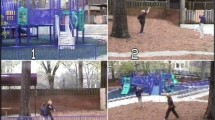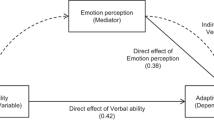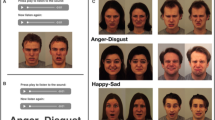Abstract
Although there is an extensive literature on domains of social skill deficits in individuals with Autism Spectrum Disorders (ASD), little research has examined the relation between specific social cognitive skills and complex social behaviors in daily functioning. This was the aim of the present study. Participants were 37 (26 male and 11 female) children and adolescents aged 6–18 years diagnosed with ASD. To determine the amount of variance in parent-rated complex social behavior accounted for by the linear combination of five directly-assessed social cognitive variables (i.e., adult and child facial and vocal affect recognition and social judgment) after controlling for general intellectual ability, a hierarchical regression analysis was performed. The linear combination of variables accounted for 35.4 % of the variance in parent-rated complex social behavior. Vocal affect recognition in adult voices showed the strongest association with complex social behavior in ASD. Results suggest that assessment and training in vocal affective comprehension should be an important component of social skills interventions for individuals with ASD.
Similar content being viewed by others
References
American Psychiatric Association. (2013). Diagnostic and statistical manual of mental disorders, 5th edition (DSM-5). American Psychiatric Association.
Baron-Cohen, S., Jolliffe, T., Mortimore, C., & Robertson, M. (1997a). Another advanced test of theory of mind: evidence from very high functioning adults with autism or asperger syndrome. Journal of Child Psychology and Psychiatry, and Allied Disciplines, 38(7), 813–822.
Baron-cohen, S., Wheelwright, S., & Jolliffe, T. (1997b). Is there a “language of the eyes”? Evidence from normal adults and adults with autism or asperger syndrome. Visual Cognition, 4(3), 311–331.
Bölte, S., & Poustka, F. (2003). The recognition of facial affect in autistic and schizophrenic subjects and their first-degree relatives. Psychological Medicine, 33(5), 907–915.
Boucher, J., Lewis, V., & Collis, G. M. (2000). Voice processing abilities in children with autism, children with specific language impairments, and young typically developing children. Journal of Child Psychology and Psychiatry, and Allied Disciplines, 41(7), 847–857.
Carrow-Woolfolk, E. (1999). Comprehensive Assessment of Spoken Language (CASL). Circle Pines: American Guidance Service.
Castelli, F. (2005). Understanding emotions from standardized facial expressions in autism and normal development. Autism: The International Journal of Research and Practice, 9(4), 428–449. doi:10.1177/1362361305056082.
Crick, N. R., & Dodge, K. A. (1994). A review and reformulation of social information-processing mechanisms in children’s social adjustment. Psychological Bulletin, 115(1), 74–101. doi:10.1037//0033-2909.115.1.74.
Demopoulos, C., & Lewine, J. D. (2015). Audiometric profiles in autism spectrum disorders: does subclinical hearing loss impact communication? Autism Research. doi:10.1002/aur.1495.
Demopoulos, C., Hopkins, J., & Davis, A. (2013). A comparison of social cognitive profiles in children with autism spectrum disorders and attention-deficit/hyperactivity disorder: a matter of quantitative but not qualitative difference? Journal of Autism and Developmental Disorders, 43(5), 1157–1170. doi:10.1007/s10803-012-1657-y.
Demopoulos, C., Hopkins, J., Kopald, B. E., Paulson, K., Doyle, L., Andrews, W. E., & Lewine, J. D. (2015). Deficits in auditory processing contribute to impairments in vocal affect recognition in autism spectrum disorders: a MEG study. Neuropsychology.
Doi, H., Fujisawa, T. X., Kanai, C., Ohta, H., Yokoi, H., Iwanami, A., … Shinohara, K. (2013). Recognition of facial expressions and prosodic cues with graded emotional intensities in adults with Asperger syndrome. Journal of Autism and Developmental Disorders, 43(9), 2099–2113. doi:10.1007/s10803-013-1760-8.
Ferri, R., Elia, M., Agarwal, N., Lanuzza, B., Musumeci, S. A., & Pennisi, G. (2003). The mismatch negativity and the P3a components of the auditory event-related potentials in autistic low-functioning subjects. Clinical Neurophysiology, 114(9), 1671–1680. doi:10.1016/S1388-2457(03)00153-6.
Gandal, M. J., Edgar, J. C., Ehrlichman, R. S., Mehta, M., Roberts, T. P. L., & Siegel, S. J. (2010). Validating γ oscillations and delayed auditory responses as translational biomarkers of autism. Biological Psychiatry, 68(12), 1100–1106. doi:10.1016/j.biopsych.2010.09.031.
Garcia Winner, M. (2002). Assessment of social skills for students with asperger syndrome and high-functioning autism. Assessment for Effective Intervention, 27(1–2), 73–80. doi:10.1177/073724770202700110.
Gepner, B., Deruelle, C., & Grynfeltt, S. (2001). Motion and emotion: a novel approach to the study of face processing by young autistic children. Journal of Autism and Developmental Disorders, 31(1), 37–45.
Golan, O., Ashwin, E., Granader, Y., McClintock, S., Day, K., Leggett, V., & Baron-Cohen, S. (2010). Enhancing emotion recognition in children with autism spectrum conditions: an intervention using animated vehicles with real emotional faces. Journal of Autism and Developmental Disorders, 40(3), 269–279. doi:10.1007/s10803-009-0862-9.
Gross, T. F. (2004). The perception of four basic emotions in human and nonhuman faces by children with autism and other developmental disabilities. Journal of Abnormal Child Psychology, 32(5), 469–480.
Korkman, M., Kirk, U., & Kemp, S. L. (2007). NEPSY II: Administrative manual. San Antonio: Psychological Corporation.
Lemerise, E. A., & Arsenio, W. F. (2000). An integrated model of emotion processes and cognition in social information processing. Child Development, 71(1), 107–118.
Lepistö, T., Kujala, T., Vanhala, R., Alku, P., Huotilainen, M., & Näätänen, R. (2005). The discrimination of and orienting to speech and non-speech sounds in children with autism. Brain Research, 1066(1–2), 147–157. doi:10.1016/j.brainres.2005.10.052.
Leppänen, J., & Hietanen, J. (2001). Emotion recognition and social adjustment in school-aged girls and boys. Scandinavian Journal of Psychology, 42, 429–435.
Lerner, M. D., McPartland, J. C., & Morris, J. P. (2013). Multimodal emotion processing in autism spectrum disorders: an event-related potential study. Developmental Cognitive Neuroscience, 3, 11–21. doi:10.1016/j.dcn.2012.08.005.
Lindner, J. L., & Rosén, L. A. (2006). Decoding of emotion through facial expression, prosody and verbal content in children and adolescents with Asperger’s syndrome. Journal of Autism and Developmental Disorders, 36(6), 769–777. doi:10.1007/s10803-006-0105-2.
Lipton, M. E., & Nowicki, S. (2009). The Social-Emotional Learning Framework (SELF): a guide for under- standing brain-based social-emotional learning impairments. The Journal of Developmental Processes, 4(2), 99–115.
Lord, C., Rutter, M., Goode, S., Heemsbergen, J., Jordan, H., Mawhood, L., & Schopler, E. (1989). Autism diagnostic observation schedule: a standardized observation of communicative and social behavior. Journal of Autism and Developmental Disorders, 19(2), 185–212.
Lord, C., Rutter, M., & Le Couteur, A. (1994). Autism diagnostic interview-revised: a revised version of a diagnostic interview for caregivers of individuals with possible pervasive developmental disorders. Journal of Autism and Developmental Disorders, 24(5), 659–685.
Lord, C., Risi, S., Lambrecht, L., Cook, E. H., Leventhal, B. L., DiLavore, P. C., … Rutter, M. (2000). The autism diagnostic observation schedule-generic: a standard measure of social and communication deficits associated with the spectrum of autism. Journal of Autism and Developmental Disorders, 30(3), 205–223.
Macintosh, K., & Dissanayake, C. (2006). A comparative study of the spontaneous social interactions of children with high-functioning autism and children with Asperger’s disorder. Autism: The International Journal of Research and Practice, 10(2), 199–220. doi:10.1177/1362361306062026.
Matsuda, S., & Yamamoto, J. (2013). Intervention for increasing the comprehension of affective prosody in children with autism spectrum disorders. Research in Autism Spectrum Disorders, 7(8), 938–946. doi:10.1016/j.rasd.2013.04.001.
Matsuzaki, J., Kagitani-Shimono, K., Goto, T., Sanefuji, W., Yamamoto, T., Sakai, S., … Taniike, M. (2012). Differential responses of primary auditory cortex in autistic spectrum disorder with auditory hypersensitivity. Neuroreport, 23(2), 113–118. doi:10.1097/WNR.0b013e32834ebf44.
Mazefsky, C. A., & Oswald, D. P. (2007). Emotion perception in Asperger’s syndrome and high-functioning autism: the importance of diagnostic criteria and cue intensity. Journal of Autism and Developmental Disorders, 37(6), 1086–1095. doi:10.1007/s10803-006-0251-6.
McKown, C. (2007). Concurrent validity and clinical usefulness of several individually administered tests of children’s social/emotional cognition. Journal of Clinical Child & Adolescent Psychology, 36(1), 29–41. doi:10.1207/s15374424jccp3601_4.
McKown, C., Gumbiner, L. M., Russo, N. M., & Lipton, M. (2009). Social-emotional learning skill, self-regulation, and social competence in typically developing and clinic-referred children. Journal of Clinical Child and Adolescent Psychology, 38(6), 858–871. doi:10.1080/15374410903258934.
Miki, K., Takeshima, Y., Watanabe, S., Honda, Y., & Kakigi, R. (2011). Effects of inverting contour and features on processing for static and dynamic face perception: an MEG study. Brain Research, 1383, 230–241. doi:10.1016/j.brainres.2011.01.091.
Murdock, L. C., Cost, H. C., & Tieso, C. (2007). Measurement of social communication skills of children with autism spectrum disorders during interactions with typical peers. Focus on Autism and Other Developmental Disabilities, 22(3), 160–172.
Nowicki, S. (2010). Manual for the receptive tests of the Diagnostic Analysis of Nonverbal Accuracy 2. Atlanta,GA.
Nowicki, S., & Duke, M. P. (1994). Individual differences in the nonverbal communication of affect: the diagnostic analysis of nonverbal accuracy scale. Journal of Nonverbal Behavior, 18(1), 9–35. doi:10.1007/BF02169077.
O’Connor, K. (2007). Brief report: impaired identification of discrepancies between expressive faces and voices in adults with Asperger’s syndrome. Journal of Autism and Developmental Disorders, 37(10), 2008–2013. doi:10.1007/s10803-006-0345-1.
Oram-Cardy, J. E., Flagg, C. A. E. J., Roberts, W., Brian, J., & Roberts, T. P. L. (2005). Magnetoencephalography identifies rapid temporal processing deficit in autism and language impairment. Neuroreport, 16(4), 329–332.
Pearson. (2009). Advanced Clinical Solutions for the WAIS-IV and WMS-IV (ACS). San Antonio: Pearson Assessments.
Ramdoss, S., Machalicek, W., Rispoli, M., Mulloy, A., Lang, R., & O’Reilly, M. (2012). Computer-based interventions to improve social and emotional skills in individuals with autism spectrum disorders: a systematic review. Developmental Neurorehabilitation, 15(2), 119–135. doi:10.3109/17518423.2011.651655.
Reynolds, C. R., & Kamphaus, R. W. (2004). Behavior Assessment System for Children-Second Edition (BASC-2) manual. Circle Pines: American Guidance Service.
Roberts, T. P. L., Khan, S. Y., Rey, M., Monroe, J. F., Cannon, K., Woldoff, S., … Edgar, J. C. (2010). MEG detection of delayed auditory evoked responses in Autism Spectrum Disorders: Towards an imaging biomarker for autism. Autism Research, 3(1), 8–18. doi:10.1002/aur.111.MEG.
Rubenstein, J. L. R. (2011). Annual research review: development of the cerebral cortex: implications for neurodevelopmental disorders. Journal of Child Psychology and Psychiatry, and Allied Disciplines, 52(4), 339–355. doi:10.1111/j.1469-7610.2010.02307.x.
Schirmer, A., & Kotz, S. A. (2006). Beyond the right hemisphere: brain mechanisms mediating vocal emotional processing. Trends in Cognitive Sciences, 10(1), 24–30. doi:10.1016/j.tics.2005.11.009.
Semel, E., Wiig, E., & Secord, W. (2003). Clinical Evaluation of Language Fundamentals-Fourth Edition (CELF-IV). San Antonio: The Psychological Corporation.
Semrud-Clikeman, M., Walkowiak, J., Wilkinson, A., & Minne, E. P. (2010). Direct and indirect measures of social perception, behavior, and emotional functioning in children with Asperger’s disorder, nonverbal learning disability, or ADHD. Journal of Abnormal Child Psychology, 38(4), 509–519. doi:10.1007/s10802-009-9380-7.
State, M. W., & Levitt, P. (2011). The conundrums of understanding genetic risks for autism spectrum disorders. Nature Neuroscience, 14(12), 1499–1506. doi:10.1038/nn.2924.
Tanaka, J. W., Wolf, J. M., Klaiman, C., Koenig, K., Cockburn, J., Herlihy, L., … Schultz, R. T. (2010). Using computerized games to teach face recognition skills to children with autism spectrum disorder: the Let’s Face It! program. Journal of Child Psychology and Psychiatry, and Allied Disciplines, 51(8), 944–952. doi:10.1111/j.1469-7610.2010.02258.x.
Tanaka, J. W., Wolf, J. M., Klaiman, C., Koenig, K., Cockburn, J., Herlihy, L., … Schultz, R. T. (2012). The perception and identification of facial emotions in individuals with autism spectrum disorders using the Let’s Face It! Emotion Skills Battery. Journal of Child Psychology and Psychiatry, and Allied Disciplines, 53(12), 1259–1267. doi:10.1111/j.1469-7610.2012.02571.x.
Wallace, G. L., Case, L. K., Harms, M. B., Silvers, J. A., Kenworthy, L., & Martin, A. (2011). Diminished sensitivity to sad facial expressions in high functioning autism spectrum disorders is associated with symptomatology and adaptive functioning. Journal of Autism and Developmental Disorders, 41(11), 1475–1486. doi:10.1007/s10803-010-1170-0.
Wang, A. T., Dapretto, M., Hariri, A. R., & Sigman, M. (2004). Neural correlates of facial affect processing in children and adolescents with autism spectrum disorder. Journal of the American Academy of Child and Adolescent Psychiatry, 43(4), 481–490. doi:10.1097/01.chi.0000111481.76722.66.
Wechsler, D. (2003). Wechsler Intelligence Scale for Children-Fourth Edition (WISC-IV). San Antonio: Pearson Assessments.
Wechsler, D. (2008). Wechsler Adult Intelligence Scale-Fourth Edition (WAIS-IV). San Antonio: Pearson Assessments.
Acknowledgments
This research was supported by the National Institute of Health (grant number HD051747-01A1). Special thanks to our participants and their families, as well as Karen Cooper, Kait DePlonty, Lindsey Felix, Corlan Keller, Brandon Kopald, Danielle Rudder, and Mona Stepansky for their help in collection of data for this manuscript.
Conflict of Interest
The authors declare that they have no conflict of interest.
Author information
Authors and Affiliations
Corresponding author
Rights and permissions
About this article
Cite this article
Demopoulos, C., Hopkins, J. & Lewine, J.D. Relations Between Nonverbal and Verbal Social Cognitive Skills and Complex Social Behavior in Children and Adolescents with Autism. J Abnorm Child Psychol 44, 913–921 (2016). https://doi.org/10.1007/s10802-015-0082-z
Published:
Issue Date:
DOI: https://doi.org/10.1007/s10802-015-0082-z




